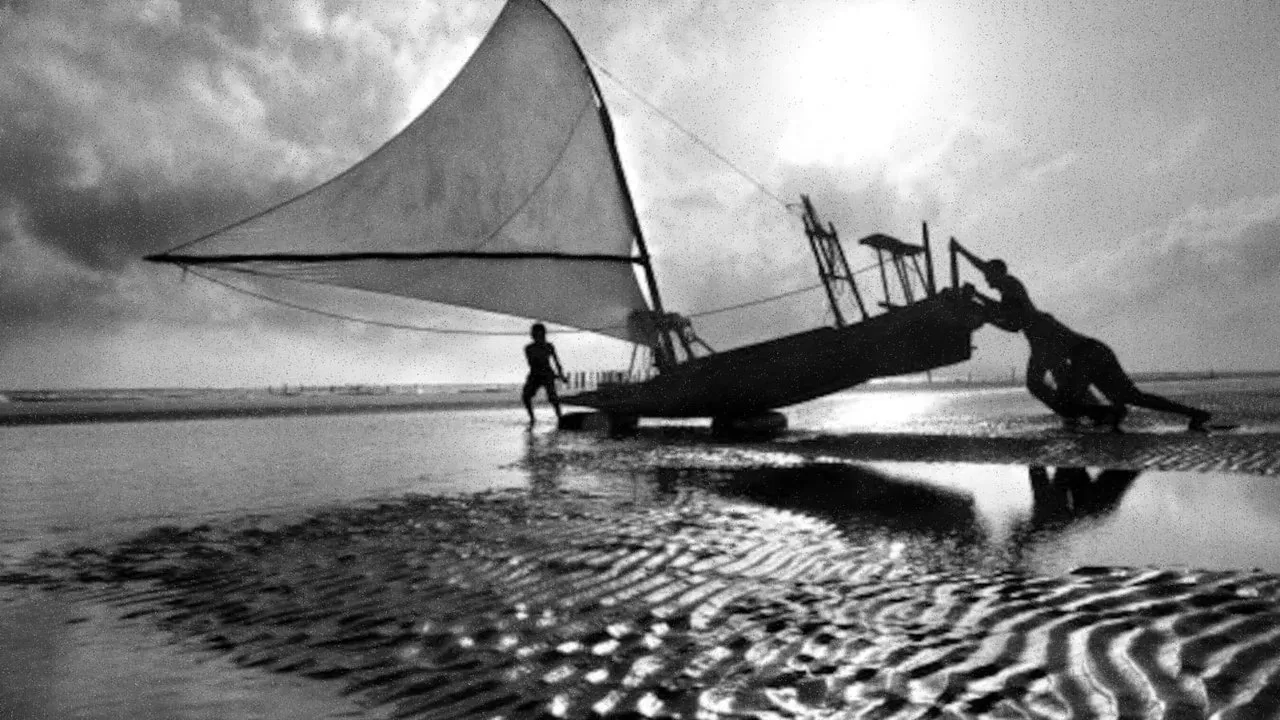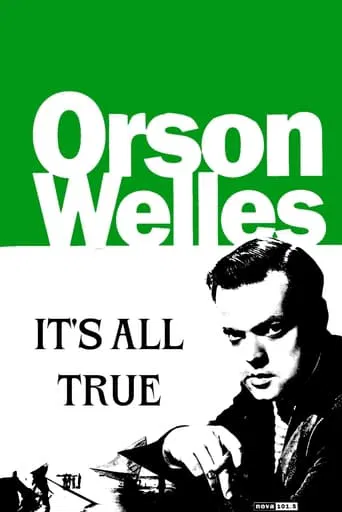

It's All True (1993)*** (out of 4) Fascinating documentary about the trouble Orson Welles fell into with RKO when he finished up THE MAGNIFICENT AMBERSONS and went to Brazil to film what was basically a South American trilogy. Welles was involved in three films: MY FRIEND BONITO, filmed in Mexico about a boy and his donkey; CARNAVAL, which footage shown here is in glorious Technicolor; and FOUR MEN ON A RAFT, which contains the majority of the footage here. IT'S ALL TRUE isn't going to be a movie for everyone and I'd imagine that most people would find it deadly dull and lifeless. Film buffs, however, should get a real kick out of it but the sad thing is that you could remake this movie a dozens times because it happened so often to Welles. The documentary starts off at the end of CITIZEN KANE when Welles was already considered controversial. It then moves onto the disastrous screening of THE MAGNIFICENT AMBERSONS where Welles thought he'd have a chance to re-edit the movie but instead the studio did it behind his back. We then get into the filming of the three films and learn of the various issues that happened including the lack of money, a curse from a voodoo man and eventually the studio taking the films away. In a bit of great luck, the footage to the three movies were discovered in 1985 and seeing the footage is interesting. CARNAVAL really stuck out to me because of the amazing colors, which just leap off the screen in Technicolor. The footage looks remarkably well and just look at the wonderful details in the costumes that the people are wearing. The stuff on FOUR MEN ON A RAFT has the most footage and also gets quite a bit of a backstory about the real event, the real tragedy and of course how Welles got involved and what he did to try and save the film. Film buffs and fans of Welles will certainly want to check this out. We get some nice interviews with people who worked on the film as well as relatives to those actual people that the film is based on.
... View MoreFrom "This Is Orson Welles" by Bogdanovich On the film: "I've never seen any of what we shot, not a foot. Nobody ever saw the rushes." On filming in South America: "I didn't even like it particularly. I liked samba, but I didn't want to go down and live in South America--it's my least favorite part of the world." On filming: "I had this enormous crew sent down--I didn't want them, but they gave me two camera crews. So I'd sent a crew out there and said, 'Shoot 'em marching up and down.' I had to keep them busy; they were always saying, 'We want to get home--we're trapped here.'...So there must have been an awful lot of junk shot, because I wasn't even there."
... View MoreIt is by sheer luck sometimes that an artist's work survives. For centuries the works of the Greek dramatist Menander did not exist except for occasional quotes (including "whom the Gods love die young"). But since 1905 one complete play, one nearly complete play, and five huge fragments exist to be studied by drama students. They were found on various papyri that managed to survive in the dry climate of Egypt.With Orson Welles there are several films which are seriously missing scenes he shot that were cut. THE MAGNIFICENT AMBERSONS is the best known (cut and a new ending attached), but there is also THE STRANGER, THE LADY FROM SHANGHAI, CONFIDENTIAL REPORT, MACBETH, and IT'S ALL TRUE to ponder. Welles had a way of making enemies due to his ego, but he was a brilliant film maker, and to see the damage these pygmies did to his work makes one angry. The fate of Konrad Meinike in THE STRANGER was to be the culmination of half an hour of activity in the film showing his escape from prison in Europe and his traveling to Latin America to locate the man he worked with - who would kill him. The famous crazy house sequence in THE LADY FROM SHANGHAI is only a small segment now of what Welles shot (that segment is still great, but the missing footage probably was superb). Restoration on CONFIDENTIAL REPORT makes it coherent now, and MACBETH now has it's original length and soundtrack. TOUCH OF EVIL too has been somewhat repaired based on the memos Welles left of his intentions for the film.IT'S ALL TRUE, unlike the other films, was never completed enough in any form to be shown to the public. Welles went to Latin America, having finished shooting AMBERSONS, and was to do a "good neighbor policy" documentary for the Roosevelt administration under the auspices of Nelson Rockefeller. He had to also cut AMBERSONS, and his finished cut version was butchered by his enemies at RKO who had it's end re-shot. Political differences with the Brazilian strongman, Getulio Vargas, helped doom IT'S ALL TRUE, and caused the footage to be left on a shelf to rot rather than to be released.Over the years film historians noted it's existence, until finally in 1990 or so some began preserving and editing the best surviving footage. Unfortunately much of the sections on "MY FRIEND BONITO" and of "The STORY OF SAMBA" was lost, but enough lasts to show Welles' eye for film was working brilliantly. Fortunately the last section, "FOUR MEN ON A RAFT" survived, and could be put into coherent form. It told the story of four poor fishermen from the north - east corner of the country with grievances, who sailed a raft (with one or two stops) all the way to Rio, in order to see President Vargas. They managed to do it. But Vargas did not really help these fisherman (one of whom was killed apparently when Welles was filming the sequence). The sequence is not only moving, but also extremely beautiful to look at. One gets the impression that Welles' Latin American documentary would have been a gorgeous one.The version of IT'S ALL TRUE is the closest we will ever have to what Welles meant to show. I recommend watching it, with the commentary sequences showing Welles at work, and his explaining the way things went wrong. Enjoy what is left. It is worth seeing.
... View MoreThe title of Orson Welles' film referred to the telling of some true stories that took place in Brazil. The title of the film about the film is also true, telling the story of one of history's legendary lost films which was re-discovered in 1985 and in still in the process of being restored. Of course, it can't all be restored because it was never finished, and in the movie Welles himself admits that he had a bad habit of pursuing projects in a way that was not profitable to him.The film Welles went to Brazil to make was part of the allied good-will efforts in World War II. Funding for the film was cut off when the head of RKO was removed and, according to Welles, as a result of this abrupt stoppage of money, the movie was cursed by a voodoo witch doctor. The curse may have worked because not only was this film never completed, but also THE MAGNIFICENT AMBERSONS, which Welles was trying to edit at the same time that he was filming in Brazil, was ruined by RKO, a member of the Brazilian cast of IT'S ALL TRUE drowned, and Welles was fired from RKO.What we see of IT'S ALL TRUE shows Welles' artistry, improvisation, and ability to capture atmosphere by means of imagery, camera angles, and characters. We see various elements of the unfinished film including the Rio carnival and the story of four heroic fishermen.Welles improvized the film as he went along, giving RKO the impression that he was really doing nothing at all. But his theme was the brotherhood of all people. RKO didn't "get it" and thus, perhaps, the voodoo curse extended itself to the studio itself because it eventually was sold to Lucy Ball and Desi Arnaz to become Desilu Studios and later was absorbed into Paramount Pictures. Studio "suits" need to be more careful before cutting off the work of artists -- a fact that Welles would certainly affirm.
... View More